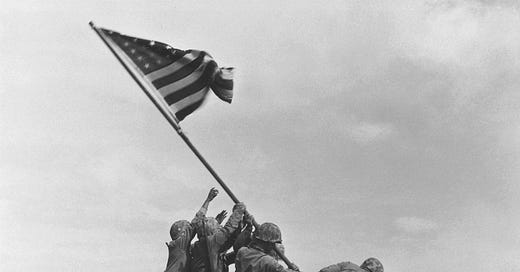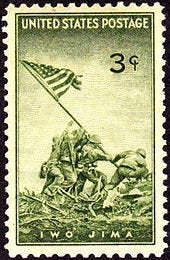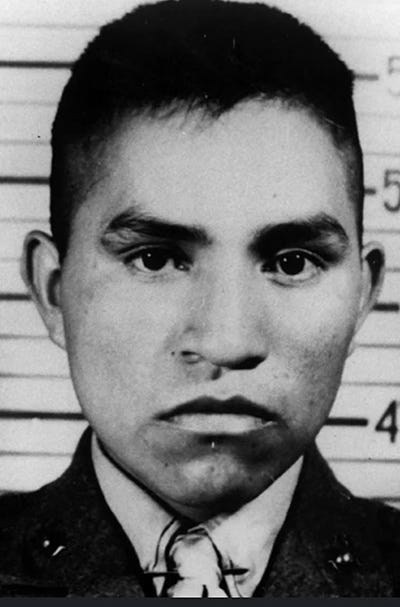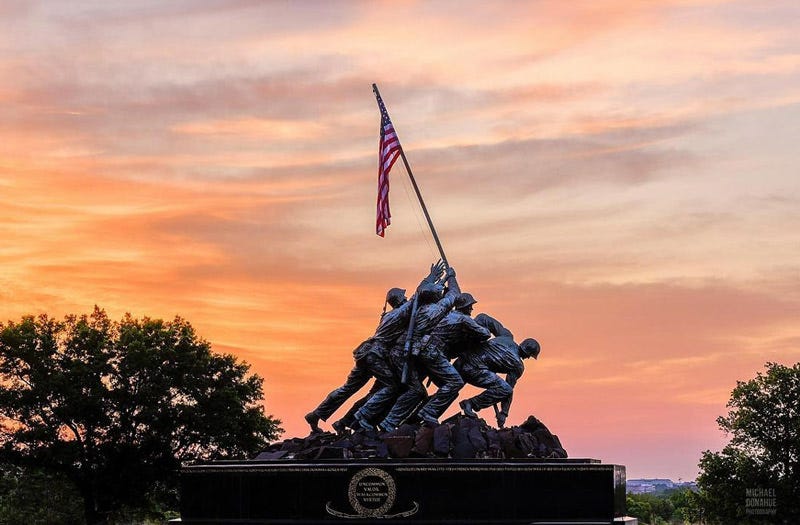Normally, my war history posts are limited to the Paid Subscribers in thanks for their support. Given the nature of this post in this time in our history, I’m putting it up for everyone.
THE FLAG RAISING AT IWO JIMA
There is perhaps no Pulitzer Prize-winning photograph better known than Joe Rosenthal’s picture of six U.S. Marines raising the American flag on Mount Suribachi on Iwo Jima, taken on Friday, Feb. 23, 1945, five days after the Marines landed on the island. The Associated Press, Rosenthal’s employer, transmitted the picture to member newspapers 17½ hours later, and it made the front pages of many Sunday papers.
The photo became a phenomenon. It was used as a poster that became the centerpiece of the Seventh War Loan Drive that raised $26 billion in the summer of 1945. By July 11, a little more than a month before the war ended, it appeared on a United States postage stamp. In 1954, it was the model for the Marine Corps War Memorial in Arlington, Va.
While the Pulitzer Prize Board normally considers journalism published in the previous calendar year for the prizes, an exception was made for Rosenthal’s picture, awarding it the 1945 prize for Photography a little over two months after it was taken.
F.A. Resch, AP’s Executive Newsphoto Editor, submitted it, supplemented by 30 others taken by Rosenthal during the battle on Iwo Jima, on March 29, 1945. The Photography jury was just finishing its work and at first did not consider it.
“We felt the material was so outstanding that it merited consideration accordingly,” Resch wrote to a Pulitzer Advisory Board member. “The endless citations which have been made in connection with the flag-raising picture — in Congress, as the basis for the Seventh War Loan drive, as the basis for numerous statue and memorial suggestions — are unprecedented in the history of news pictures.”
Resch pointed out that the AP had transmitted to its members half the 60 pictures Rosenthal took on Iwo Jima. “To the best of my knowledge no news photographer on any assignment before or during this war has achieved such results either in terms of so many newsworthy pictures taken under dangerous conditions, or in terms of consistently high technical quality of the product.”
The Pulitzer Advisory Board acknowledged receipt of the photos on April 18 and assured Fesch they would receive consideration. A short time later, it was announced that the Rosenthal photo had won the prize.
Here is Rosenthal’s own story about the picture, which the AP put out on March 7, 1945, less than two weeks after the flag-raising.
I HOPE THIS WAS WORTH THE EFFORT
“See that spot of red on the mountainside?” the bos’n shouted above the noise of our landing craft nearing the shore at the base of Suribachi Yama.
“A group of Marines is climbing up to plant our flag up there. I heard it from the radioman.”
“He was plenty excited — and so was I.
“The fall of this 560-foot fortress in four days of gallant marine fighting was a great thing. A good story and we should have good pictures.
“So in I went, back to more of that slogging thru the deep volcanic ash, warily sidestepping the numerous Japanese mines. On past the culverts where the Japanese dead lay among the wreckage of their own gun positions and up the steep, winding, always sandy trail.
“Marine Pvt. Bob Campbell, a San Francisco buddy of mine, and Sgt. Bill Janausk of Tacoma, Wash., were with me and carried firearms for protection (which is disallowed to correspondents).
“There was an occasional sharp crack of rifle fire close by and the mountainside had a porcupine appearance of bristling all over, what with machine and anti-aircraft guns peering from the dugouts, foxholes and caves. There were few signs of life from these enemy spots, however. Our men were systematically blowing out these places and we had to be on our toes to keep clear of our own demolition squads.
“As the trail became steeper, our panting progress slowed to a few yards at a time. I began to wonder and hope that this was worth the effort, when suddenly over the brow of the topmost ridge we could spy men working with the flagpole they had so laboriously brought up about A quarter of an hour ahead of us.
“I came up and stood by a few minutes until they were ready to swing the flagpole into position.
“I crowded back on the inner edge of the volcano’s rim, back as far as I could, in order to include all I could into the scene within the angle covered by my camera lens.
“I rolled up a couple of large stones and a Japanese sandbag to raise my short height clear of an intervening obstruction. I followed up this shot with another of a group of cheering Marines and then I tried to find the four men I heard were the actual instigators of the grand adventure. But they had scattered to their units and I finally gave it up and descended the mountain to get the pictures out and on their way to possible publication.
“The way down was quite a bit easier, the path becoming well worn, and men were carrying ammunition, supplies, food and rations necessary for complete occupation of this stronghold.
“The Marine history will record Iwo Jima as high as any in their many gallant actions in the Pacific.
“I have two very vivid memories: The fury of their D-day assault and the thrill of that lofty flag-raising episode.
“It is hard now in the quiet atmosphere of this advance base to find words for it. The Marines at Iwo Jima were magnificent.”
The Two Flag Raisings on Iwo Jima:
The first flag raising
On the morning of February 23, 1945, 1st Lt. Harold G. Schrier, executive officer of Easy Company, 2nd Battalion, 28th Marine Regiment, 5th Marine Division volunteered to lead a 40-man combat patrol up the mountain when the platoon leader was injured. They captured the top of the mountain some time after 1000 hours and set about raising the United States flag on a piece of piping that had been used by the Japanese to capture rainwater.
The Secretary of the Navy, James Forrestal, was coming ashore at the moment when this flag went up. It was just a speck in the distance but he immediately recognized its symbolic significance, turning to General Holland "Howlin' Mad" Smith, who was accompanying him and saying: “Holland, the raising of that flag on Suribachi means a Marine Corps for the next five hundred years.”
James Forrestal on Iwo Jima
Forrestal decided he wanted the flag as a souvenir. Lt Colonel Chandler Johnson, commander of the Marine battalion whose men had raised the flag, sent a lieutenant to retrieve that first flag and to arrange for a replacement to be raised in its place, with a member of the press on hand.
Joe Rosenthal, was not especially well prepared for the event: “Out of the corner of my eye, I had seen the men start the flag up. I swung my camera and shot the scene. That is how the picture was taken, and when you take a picture like that, you don't come away saying you got a great shot. You don't know.”
Mount Suribachi loomed over the whole island, the dominant feature whose capture in most battles would have signaled the end of the battle. In fact the struggle for control of the island was very far from over. While the Marines held the high ground, most of the Japanese defenders remained underground. The island was not declared secure until March 26, 1945
The invasion of Iwo Jima February 19, 1945 - Mount Suribachi on left
Of the 40 men in the combat team that first climbed Mount Suribachi and raised t he flad, 36 were killed or wounded in the following weeks before the island was finally declared secure on March 26, 1945..
“Marines at Iwo Jima”- The 3 cent postage stamp issued in Washington, D.C. on 11th July 1945 - 137,321,000 stamps were sold, raising over $4 million for the Seventh War Loan.
At one point there was question whether the photo was staged. Marine Bob Campbell’s photo proved it wasn’t:
Bob Campbell’s photo
Only three of the six men who actually raised the flag survived the battle. One was Ira Hayes, an Akimel O'odham American. He and t he other two surviving Marines wer assigned to take part in the Seventh War Loan Drive and were feted across America. All three were suffering from PTSD as a result of their experience on the island. Ira Hayes never recovered; in postwar America, PTSD was something kids knew about when they decided not to visit their friend’s home again after meeting his “scary father.” Like many other survivors of The Greatest Generation, he descended into alcoholism in an attempt to blot out the nightmares he couldn’t deal with.
Ira Hayes
On November 10, 1954, Hayes attended the dedication of the Marine Corps War Memorial in Arlington County, Virginia, modeled after the photograph of Hayes and the five other Marines raising the second flag on Iwo Jima. He stayed in Washington after the ceremony when a former Marine tried to help him. After a night of heavy drinking on January 23–24, 1955, he died of exposure due to the cold and alcohol poisoning in Washington D.C.. He was buried with full military honors at Arlington National Cemetery on February 2, 1955.
Johnny Cash first performed “Ira Hayes” at the 1964 Newport folk Festival:
Bill Mauldin also won a Pulitzer for News Cartooning in 1945 for this from the Italian Front:












I’m crying.
A former US Marine (RVN) I truly appreciate you posting Lou Lowrey's image of the first flag raising. I love Rosenthal's iconic photograph but something about the first image has gravity as well. Thank you for this post.